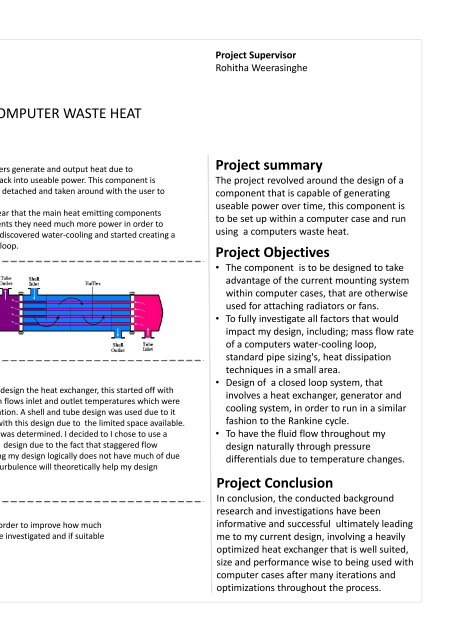UWE Bristol Engineering showcase 2015
You also want an ePaper? Increase the reach of your titles
YUMPU automatically turns print PDFs into web optimized ePapers that Google loves.
Joshua Giffin<br />
BEng – Mechanical <strong>Engineering</strong><br />
Project Supervisor<br />
Rohitha Weerasinghe<br />
DESIGN OF A PRODUCT CAPEABLE OF UTILISING COMPUTER WASTE HEAT<br />
Introduction<br />
The computer industry is a very large one with the vast majority of people using them daily. Such computers generate and output heat due to<br />
inefficiency's. My project is based around designing a component to utilize this waste heat converting it back into useable power. This component is<br />
designed to be set up and left within a computer case, charging reusable battery's overtime, these can be detached and taken around with the user to<br />
charge devices on the go.<br />
While it is true that almost all components within a computer that run on electricity generate heat, it’s clear that the main heat emitting components<br />
within modern computers are the CPU and GPU, due to the fact that in comparison to the other components they need much more power in order to<br />
operate, after initially looking at ways to capture and utilise the heat from each component individually, I discovered water-cooling and started creating a<br />
design capable of utilising the heat from all components as it’s being transferred through a water-cooling loop.<br />
Concept<br />
This project investigates and leads to the design of a closed loop design that has similarity's<br />
with the Rankine cycle. The design consists of a shell and tube heat exchanger that transfers<br />
heat into the closed loop design from the computers water-cooling loop, a generator to take<br />
advantage of generated velocity's and a water-cooling radiator to cool the coolant , allowing<br />
pressure differentials to occur and movement within the loop to occur.<br />
Background Research<br />
My initial research was into computers and their main heat<br />
emitting components. This lead me into water-cooling<br />
designs and hence ultimately to my final design idea.<br />
I was then able to look into and determine values such as<br />
the water-cooling loops mass flow rate alongside average<br />
ambient / computer running temperatures. Which were<br />
later used within the heat exchanger design process.<br />
Heat Exchanger Design<br />
An eight step design process was used to design the heat exchanger, this started off with<br />
me specifying the mass flow rate and each flows inlet and outlet temperatures which were<br />
determined by research and logical evaluation. A shell and tube design was used due to it<br />
being compact, this feature ties in nicely with this design due to the limited space available.<br />
Following this the LMTD correction factor was determined. I decided to I chose to use a<br />
staggered flow pipe design over an in-line design due to the fact that staggered flow<br />
designs create more turbulence, something my design logically does not have much of due<br />
to low flow speeds and compact spaces. Turbulence will theoretically help my design<br />
transfer heat more efficiently.<br />
Further Work<br />
Future work for this project includes additional investigations into generators alongside optimizations in order to improve how much<br />
power can be generated over a given time period. Additionally, methods of velocity manipulation could be investigated and if suitable<br />
implemented into the design.<br />
Project summary<br />
The project revolved around the design of a<br />
component that is capable of generating<br />
useable power over time, this component is<br />
to be set up within a computer case and run<br />
using a computers waste heat.<br />
Project Objectives<br />
• The component is to be designed to take<br />
advantage of the current mounting system<br />
within computer cases, that are otherwise<br />
used for attaching radiators or fans.<br />
• To fully investigate all factors that would<br />
impact my design, including; mass flow rate<br />
of a computers water-cooling loop,<br />
standard pipe sizing's, heat dissipation<br />
techniques in a small area.<br />
• Design of a closed loop system, that<br />
involves a heat exchanger, generator and<br />
cooling system, in order to run in a similar<br />
fashion to the Rankine cycle.<br />
• To have the fluid flow throughout my<br />
design naturally through pressure<br />
differentials due to temperature changes.<br />
Project Conclusion<br />
In conclusion, the conducted background<br />
research and investigations have been<br />
informative and successful ultimately leading<br />
me to my current design, involving a heavily<br />
optimized heat exchanger that is well suited,<br />
size and performance wise to being used with<br />
computer cases after many iterations and<br />
optimizations throughout the process.


